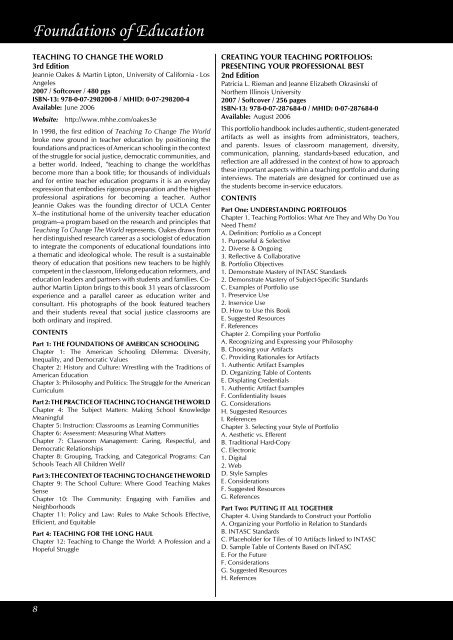table of contents - McGraw-Hill Books
table of contents - McGraw-Hill Books
table of contents - McGraw-Hill Books
Create successful ePaper yourself
Turn your PDF publications into a flip-book with our unique Google optimized e-Paper software.
Foundations <strong>of</strong> Education<br />
TEACHING TO CHANGE THE WORLD<br />
3rd Edition<br />
Jeannie Oakes & Martin Lipton, University <strong>of</strong> California - Los<br />
Angeles<br />
2007 / S<strong>of</strong>tcover / 480 pgs<br />
ISBN-13: 978-0-07-298200-8 / MHID: 0-07-298200-4<br />
Available: June 2006<br />
Website: http://www.mhhe.com/oakes3e<br />
In 1998, the first edition <strong>of</strong> Teaching To Change The World<br />
broke new ground in teacher education by positioning the<br />
foundations and practices <strong>of</strong> American schooling in the context<br />
<strong>of</strong> the struggle for social justice, democratic communities, and<br />
a better world. Indeed, "teaching to change the world?has<br />
become more than a book title; for thousands <strong>of</strong> individuals<br />
and for entire teacher education programs it is an everyday<br />
expression that embodies rigorous preparation and the highest<br />
pr<strong>of</strong>essional aspirations for becoming a teacher. Author<br />
Jeannie Oakes was the founding director <strong>of</strong> UCLA Center<br />
X--the institutional home <strong>of</strong> the university teacher education<br />
program--a program based on the research and principles that<br />
Teaching To Change The World represents. Oakes draws from<br />
her distinguished research career as a sociologist <strong>of</strong> education<br />
to integrate the components <strong>of</strong> educational foundations into<br />
a thematic and ideological whole. The result is a sustainable<br />
theory <strong>of</strong> education that positions new teachers to be highly<br />
competent in the classroom, lifelong education reformers, and<br />
education leaders and partners with students and families. Coauthor<br />
Martin Lipton brings to this book 31 years <strong>of</strong> classroom<br />
experience and a parallel career as education writer and<br />
consultant. His photographs <strong>of</strong> the book featured teachers<br />
and their students reveal that social justice classrooms are<br />
both ordinary and inspired.<br />
CONTENTS<br />
Part 1: THE FOUNDATIONS OF AMERICAN SCHOOLING<br />
Chapter 1: The American Schooling Dilemma: Diversity,<br />
Inequality, and Democratic Values<br />
Chapter 2: History and Culture: Wrestling with the Traditions <strong>of</strong><br />
American Education<br />
Chapter 3: Philosophy and Politics: The Struggle for the American<br />
Curriculum<br />
Part 2: THE PRACTICE OF TEACHING TO CHANGE THE WORLD<br />
Chapter 4: The Subject Matters: Making School Knowledge<br />
Meaningful<br />
Chapter 5: Instruction: Classrooms as Learning Communities<br />
Chapter 6: Assessment: Measuring What Matters<br />
Chapter 7: Classroom Management: Caring, Respectful, and<br />
Democratic Relationships<br />
Chapter 8: Grouping, Tracking, and Categorical Programs: Can<br />
Schools Teach All Children Well?<br />
Part 3: THE CONTEXT OF TEACHING TO CHANGE THE WORLD<br />
Chapter 9: The School Culture: Where Good Teaching Makes<br />
Sense<br />
Chapter 10: The Community: Engaging with Families and<br />
Neighborhoods<br />
Chapter 11: Policy and Law: Rules to Make Schools Effective,<br />
Efficient, and Equi<strong>table</strong><br />
Part 4: TEACHING FOR THE LONG HAUL<br />
Chapter 12: Teaching to Change the World: A Pr<strong>of</strong>ession and a<br />
Hopeful Struggle<br />
CREATING YOUR TEACHING PORTFOLIOS:<br />
PRESENTING YOUR PROFESSIONAL BEST<br />
2nd Edition<br />
Patricia L. Rieman and Jeanne Elizabeth Okrasinski <strong>of</strong><br />
Northern Illinois University<br />
2007 / S<strong>of</strong>tcover / 256 pages<br />
ISBN-13: 978-0-07-287684-0 / MHID: 0-07-287684-0<br />
Available: August 2006<br />
This portfolio handbook includes authentic, student-generated<br />
artifacts as well as insights from administrators, teachers,<br />
and parents. Issues <strong>of</strong> classroom management, diversity,<br />
communication, planning, standards-based education, and<br />
reflection are all addressed in the context <strong>of</strong> how to approach<br />
these important aspects within a teaching portfolio and during<br />
interviews. The materials are designed for continued use as<br />
the students become in-service educators.<br />
CONTENTS<br />
Part One: UNDERSTANDING PORTFOLIOS<br />
Chapter 1. Teaching Portfolios: What Are They and Why Do You<br />
Need Them?<br />
A. Definition: Portfolio as a Concept<br />
1. Purposeful & Selective<br />
2. Diverse & Ongoing<br />
3. Reflective & Collaborative<br />
B. Portfolio Objectives<br />
1. Demonstrate Mastery <strong>of</strong> INTASC Standards<br />
2. Demonstrate Mastery <strong>of</strong> Subject-Specific Standards<br />
C. Examples <strong>of</strong> Portfolio use<br />
1. Preservice Use<br />
2. Inservice Use<br />
D. How to Use this Book<br />
E. Suggested Resources<br />
F. References<br />
Chapter 2. Compiling your Portfolio<br />
A. Recognizing and Expressing your Philosophy<br />
B. Choosing your Artifacts<br />
C. Providing Rationales for Artifacts<br />
1. Authentic Artifact Examples<br />
D. Organizing Table <strong>of</strong> Contents<br />
E. Displating Credentials<br />
1. Authentic Artifact Examples<br />
F. Confidentiality Issues<br />
G. Considerations<br />
H. Suggested Resources<br />
I. References<br />
Chapter 3. Selecting your Style <strong>of</strong> Portfolio<br />
A. Aesthetic vs. Efferent<br />
B. Traditional Hard-Copy<br />
C. Electronic<br />
1. Digital<br />
2. Web<br />
D. Style Samples<br />
E. Considerations<br />
F. Suggested Resources<br />
G. References<br />
Part Two: PUTTING IT ALL TOGETHER<br />
Chapter 4. Using Standards to Construct your Portfolio<br />
A. Organizing your Portfolio in Relation to Standards<br />
B. INTASC Standards<br />
C. Placeholder for Tiles <strong>of</strong> 10 Artifacts linked to INTASC<br />
D. Sample Table <strong>of</strong> Contents Based on INTASC<br />
E. For the Future<br />
F. Considerations<br />
G. Suggested Resources<br />
H. Refernces<br />
8

















